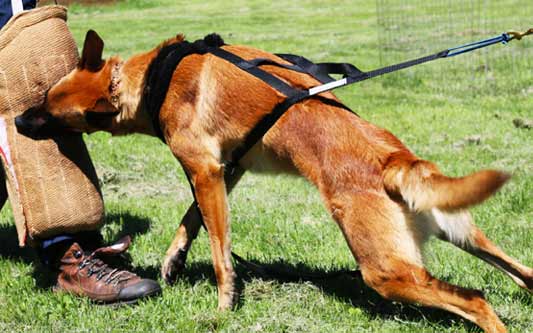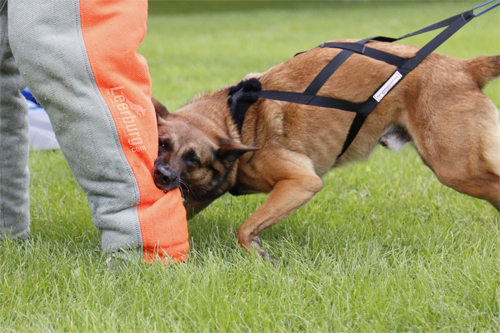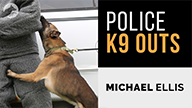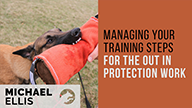My Dog Won't Out

If you are around bite work long enough, you will eventually see dogs that simply “will not” out. Nothing their handler does can persuade the dog to release, not prong collar corrections, not remote collar corrections.
We get emails from handlers of these kinds of dogs on a regular basis asking “What can be done to fix this problem?” The majority of people who write have bought these dogs and are now seeing the problem.
I have a two year old working dog. He is mixed, GSD/Mal. I have had him for nine months now. He was imported from Hungary. We completed a our certification in police work. During that time, I had trouble outing him. It was choke off mostly. He has a high prey drive and is over the top for bite work. Suits, sleeves, and tugs brings out an extreme drive.
Since then, I've purchased some of your videos; Engagement, Basic OB, Ecollar.
In the past, he wouldn't release a toy or tug. I have been using different methods to get him to out.
Right now, I can have him out a tug or toy on command. The issue is he won't out when I'm holding the object or if he is on a sleeve. It sends him into over drive. I'm looking for any suggests or tips that would help.
To begin with, I am sure the previous owner saw this coming or there were related behavioral issues that resulted in the dog which is why it was sold. It's possible the dog is returned to the breeder and he or she sells it to someone like you.
There is also one other scenario with the dog in the above email. The dog could have been a product of the military/police market where dogs are bred and raised in a breeding station for one reason: to pass a selection test. That test is intended to demonstrate drive or at least the appearance of drive, often by using conflict to get the behaviors people in the market are looking for. These dogs are taught to satisfy drive through conflict regardless of the cost.
In the end, these dogs are a product of bad training. There were mistakes made in the foundation of bite work and/or the dogs are a product of poor management from an early age.
During puppy or young dog training, they were repeatedly allowed to practice bad behavior (such as not releasing toys or bite work prey items when asked). When there were no consequences, that behavior in ignoring the OUT became stronger and stronger.
When we break this down, we have a dog that won't release because the dog feels the prey item is theirs and you're trying to take HIS ITEM away. These kinds of dogs all have a very hard temperament. This simply means they are not very reactive to corrections, they can take a licking and keep on coming.
Some dogs develop the attitude that they can take anything you do to them (with a prong collar, remote collar, or choke collar, etc.) because they know if they hang on long enough, the FORCE (your corrections) will eventually end and they will still have their prey item. These kinds of dogs go into a mental state of mind that is like a trance.
The thing is this dog is not in that frame of mind 100% of the time. That's why owners can take some items (i.e. toys) away and other times the dog will never give up training items like bite sleeves.
So how do you fix this?
The bottom line is there is no simple answer. Most people can never fix it because they simply lack the experience. I also believe some dogs have been allowed to act like this for so long that the problem can never be permanently fixed, not even by a professional dog trainer experienced in bite work.
If there is a solution, it always begins with developing a really good handler relationship between the handler and dog that is based on trust and respect.
The training also needs to go back to the very beginning of tug work. Just as we have high-value food rewards, dogs also have toys that vary in value. Obviously, bite sleeves worn by decoys have an extreme value for dogs like the one in the email while toys carry less of a value.
So in the beginning, retraining starts in calmer environments with low-value toys. The goal of the initial training begins by teaching the dog that when it executes OUT on command, it immediately gets to re-engage the toy. The handler “marks” with YES and instantly re-engages. This can be done a number of times in a short training session before the handler gives the “ALL DONE” command and the toy is put away.
Toys are never left with dogs like this. Doing so just promotes possession issues with the dog. Putting the toy up after training teaches the dog that toys are your toys and you allow him to play with your toys.
The DVD I did with Michael Ellis titled The Power of Playing Tug with Your Dog teaches how to play tug in this manner. In this training video, we show how to train inexperienced dogs how to out the tug. With dogs like this, it's best to put very little energy into the game. This reduces the dogs going into their trance.
If you are not familiar with marker training, that is covered in the DVD I also did with Michael titled The Power of Training Dogs with Food. In my opinion, it's very important the dog and handler understand Markers. Teaching the ALL DONE command is covered in this video.
Once the handler understands the tug and food games, he/she should do the work in Teaching Protection Skills Without a Decoy. All of this work is started with items used in bite training (i.e., tugs, bite pillows, and bite sleeves) by the handler at a low energy level with the goal being to keep the dog out of the TRANCE LIKE STATE OF MIND. As the training progresses, the energy level is slowly increased with the handler always looking for the edge of the dog's trance.
Up to this point, everything has been a structured repetitive training program. In my opinion, if a trainer cannot get past this work, if they can't get the dog to OUT during this work, he/she will never be able to get the dog to OUT off a fighting decoy.
It's during this part of re-training that a real working relationship is developed. Some dogs learn to trust their new handler. Some dogs will learn to accept a serious verbal correction when they won't out. Some are so far gone they will never accept it.
If your dog has any tendency towards handler aggression, then you need to stop this work and accept the fact that this dog is beyond your training skills. You have to be honest with yourself if it's time to rehome the dog.
If the dog can work at this level, then you can try the same work in a neutral environment with a decoy. Several important things about this training stage:
- Keep each bite session short. Keep the time on the prey item very calm and short. If the decoy struggles or fights too much, the dog will go back into the trance.
- When the fight is dramatically reduced, most dogs will OUT. The decoy marks that behavior and immediately offers another quick bite. We want the dog to realize the OUT does not mean the end of the game. We also want the dog to realize that the decoy can communicate good behavior (by marking the OUT)
From here, the distractions are slowly increased. This means the game is taken up a notch one step at a time. Always looking for the edge of the trance.
If the dog can respond well in a neutral area, then the distraction can slowly be amped up, always looking for the edge of the dog's control.
In the end, this work often requires an experienced handler and decoy. There are no shortcuts. A lot of people try but very few are successful.
I will also say that a lot of people call themselves professional dog trainers when they actually have little to no experience with this kind of dog. Trainers who have even titled a number of dogs in the biting dog sports are not qualified to problem solve dogs like this. So be careful about who you ask for help.










Ask Cindy.